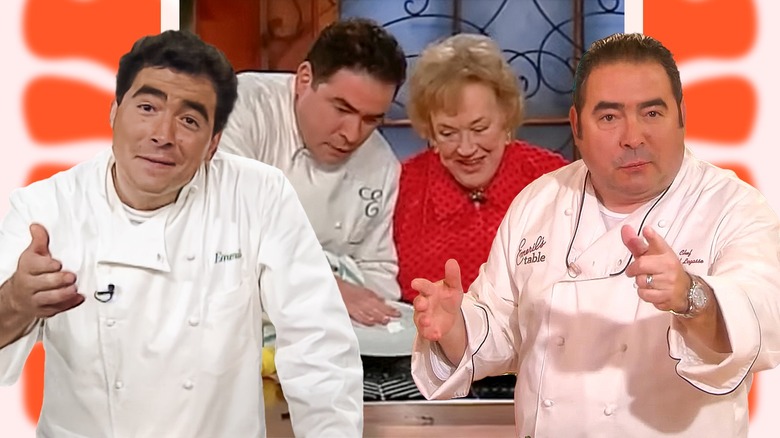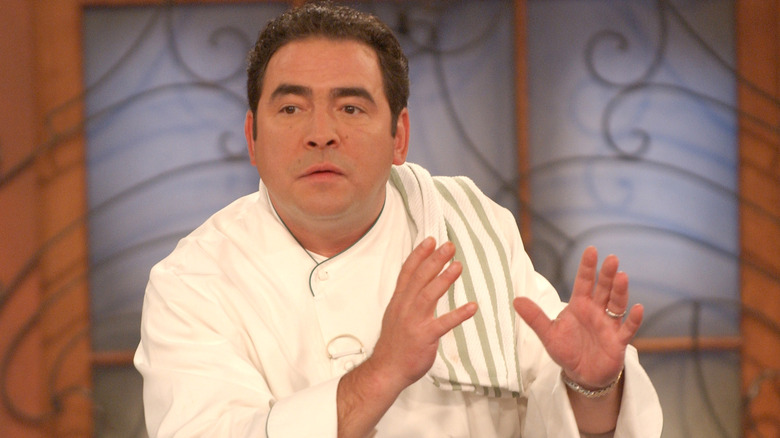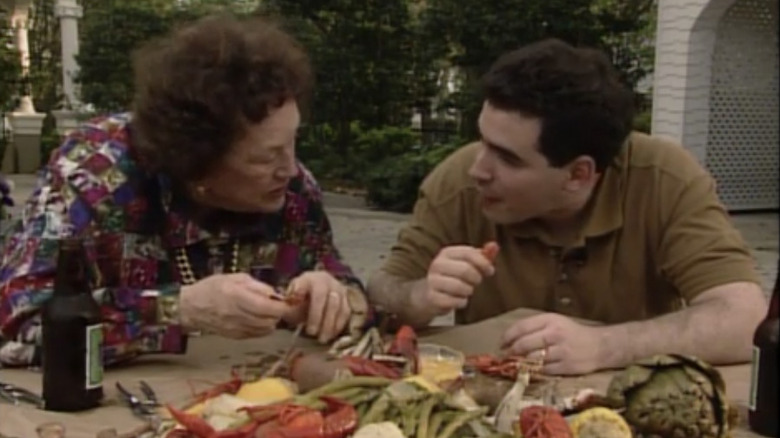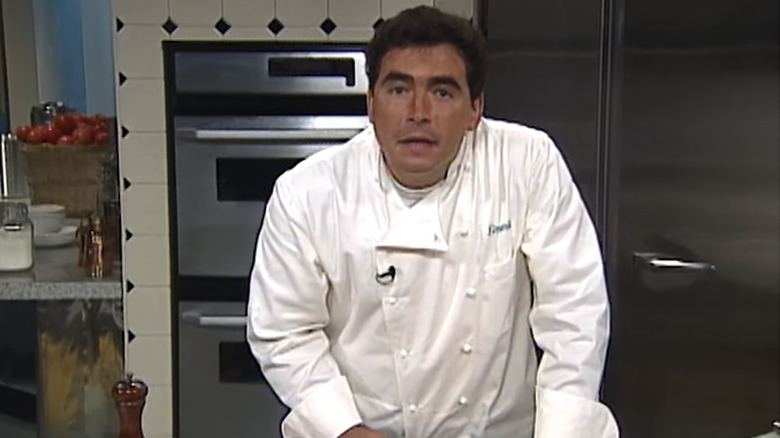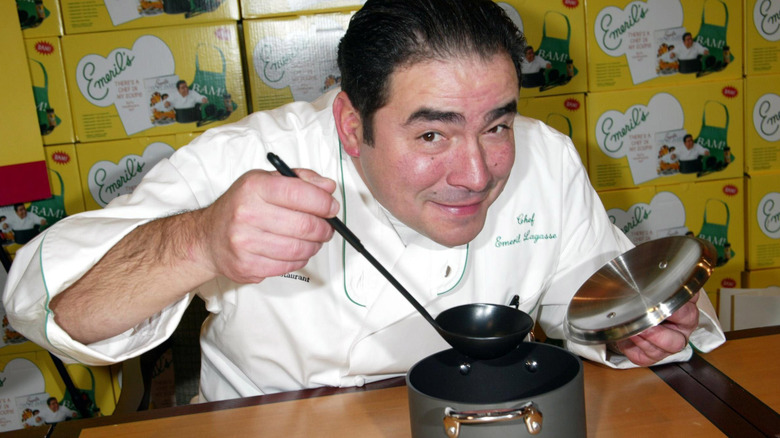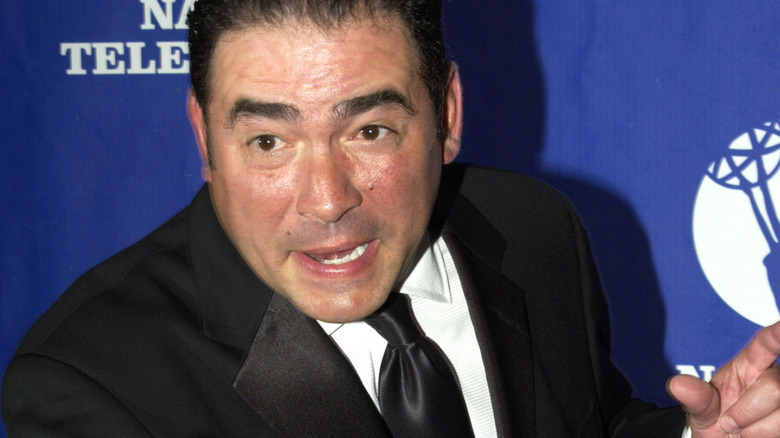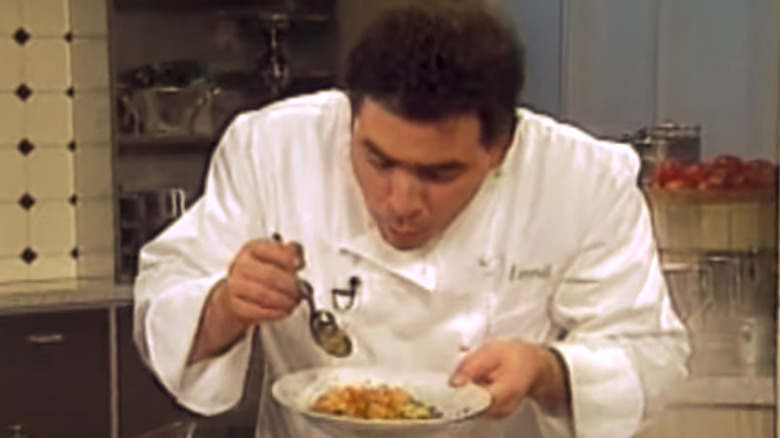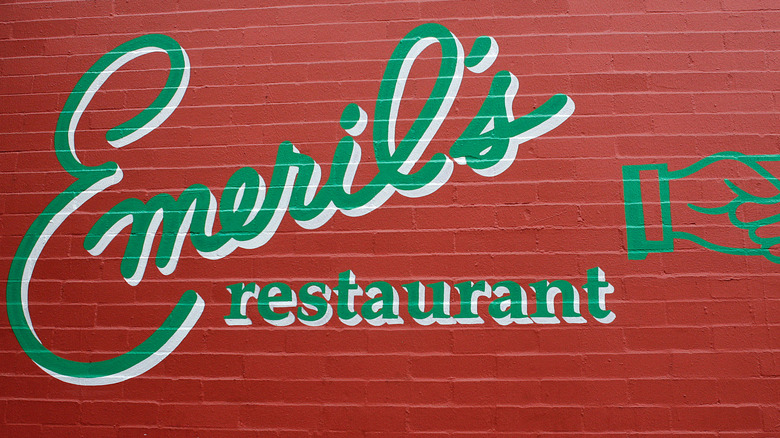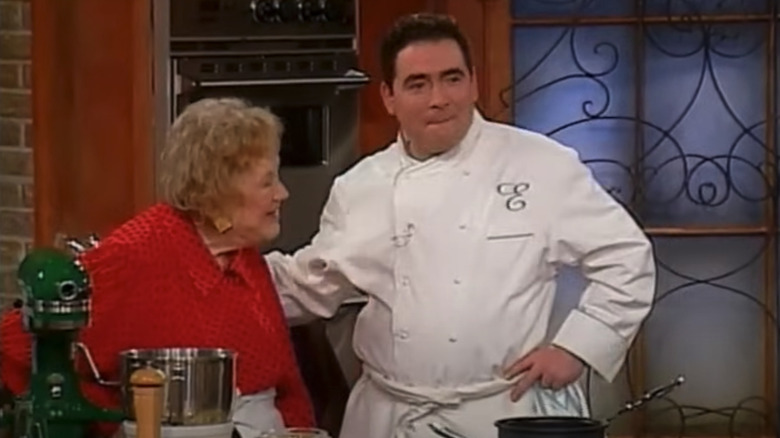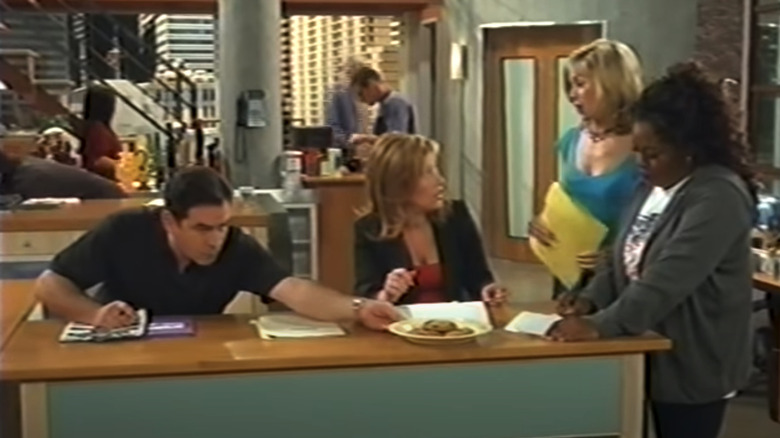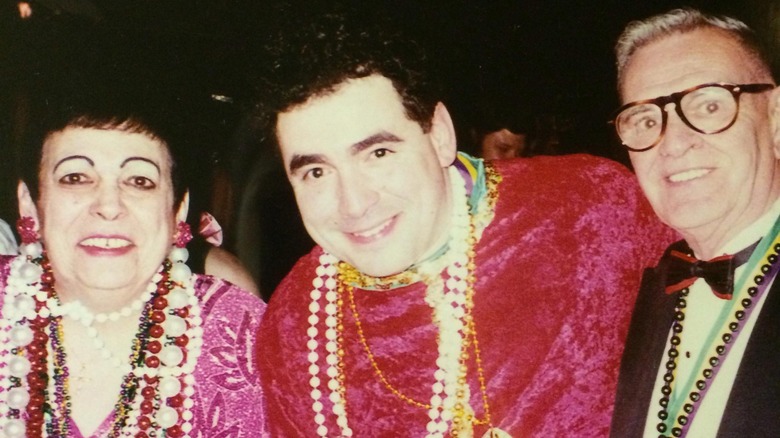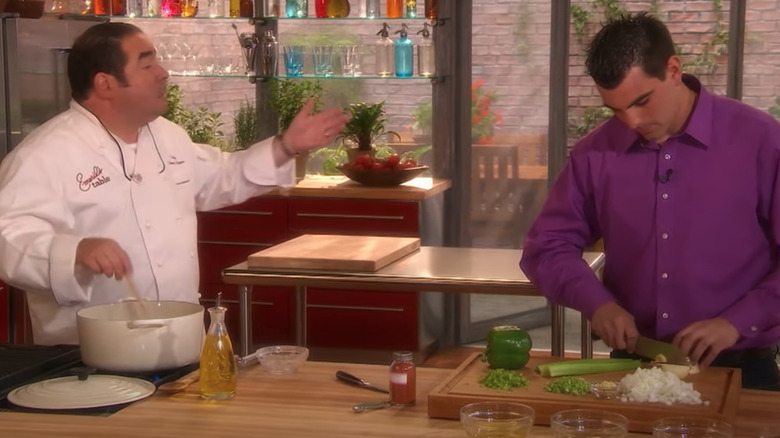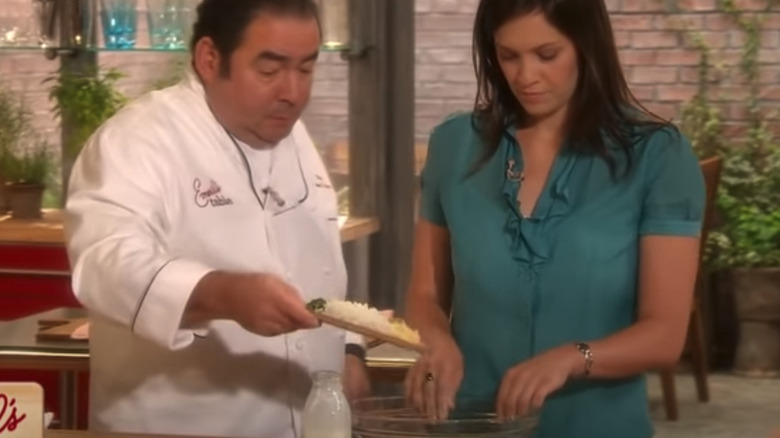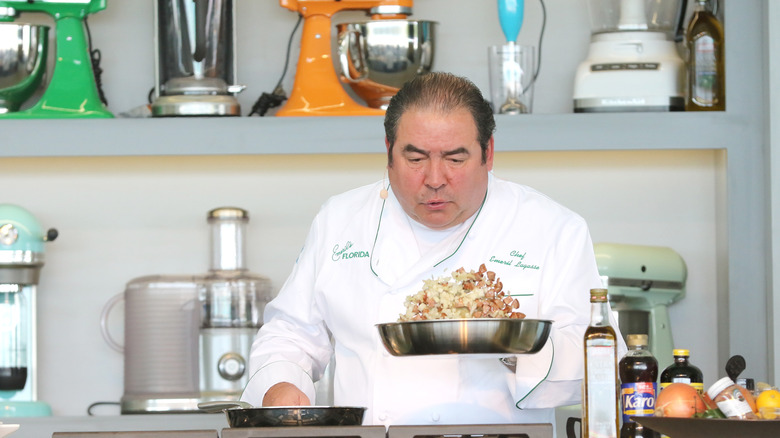The Forgotten Gems Of Emeril Lagasse's Early TV Career
We may receive a commission on purchases made from links.
By the time Emeril Lagasse scored his first Food Network slot in 1993, he was already well on his way to becoming the famed chef he is today. He had his first professional kitchen jobs in the Northeast, but by the age of 23 he was the executive chef at Commander's Palace in New Orleans. It was there that Lagasse learned the ins and outs of traditional Cajun and Creole cooking, and began to put his own spin on classic regional dishes.
Lagasse opened his own first New Orleans restaurant in 1990, called Emeril's Restaurant. Within the year he was earning accolades and making a name for himself in the culinary industry. But it wasn't until he landed a spot on the fledgling Food Network that he started to become a household name. It was on the screen that Lagasse developed the magnetic persona he's known for; encouraging his audiences to take their recipes "up a notch" and shouting "Bam!" when a recipe called for extra pizazz.
Lagasse is renowned for the ways he brought Louisiana cooking into the spotlight, but he stayed in that spotlight because of his ability to convey his passion for cooking to thousands of home cooks. Looking back at early clips of his cooking shows, it's easy to see why he quickly became a beloved staple in the Food Network lineup. We've rounded up some of the highlights about those first shows he hosted that demonstrate why Lagasse was (and is) such a legend.
Emeril's first hosting gig on the Food Network was for How to Boil Water
In 1993, producers at the Food Network were debating who should host their upcoming new program, "How to Boil Water," a show dedicated to teaching home cooks kitchen basics. Lagasse, though at 33 was totally unproven as a television host, was chosen for his youth and appeal toward female viewers, according to "From Scratch: Inside the Food Network."
Lagasse was initially hesitant to take the job. He had already been awarded Best Southeast Regional Chef by the James Beard Foundation and won coveted restaurant awards for Emeril's and NOLA, his two restaurants at the time. "Gee, I don't know," Lagasse told a producer. "I'm going to teach people how to boil water? I'm going to show them how to make grilled cheese sandwiches?" Ultimately, Lagasse decided it was worth a shot, and that first foray into television launched his on-screen career. Lagasse was only the host for a couple of years before launching namesake programs of his own, but the long-running show still airs today, hosted by chef Tyler Florence and comedian Jack Hourigan.
Lagasse served Julia Child her first crawfish boil
Right around the time Lagasse was filming "How to Boil Water," he was chosen by Julia Child to star in the premiere episode of her new PBS show, "Julia Child: Cooking With Master Chefs." The 1993 episode highlights what had propelled Lagasse to early fame: new ways to celebrate New Orleans cuisine. He prepares Shrimp Étouffée on set, and finishes with a backyard crawfish boil complete with vegetables, potatoes, crab, corn, and crawfish.
"I've been in New Orleans a number of times, but I've never had a crab boil," Child remarks as Lagasse pours the contents of a giant steamer pot onto a paper-covered outdoor table. Lagasse shows Child the proper way to eat the crawfish, which he affectionately calls "mud bugs." Lagasse twists the heads off with ease, sucking out the juices before peeling and pinching the crawfish tails to release the seafood within. According to "From Scratch," Lagasse cheekily boasted later that he taught Child how to "suck head and pinch tail."
He devoted an entire episode of Essence of Emeril to cooking roasted chicken
If Lagasse's first Food Network venture was about proving he was ready to anchor a TV set, his first namesake show, "Essence of Emeril," was about showcasing his mastery of New Orleans cuisine. The show, which first aired in 1994, allowed Lagasse to demonstrate his transformation from merely a skilled chef to one who deeply understood and celebrated Louisiana cooking.
"I'm going to use different recipes to show you how my cooking has evolved over the years into what I call new New Orleans cuisine," Lagasse said. Early episodes of "Essence of Emeril" had callbacks to his stint on "How to Boil Water." In Episode 3, Lagasse spent several minutes breaking down a whole chicken. Buying a whole chicken is cheaper per pound than purchasing pre-cut portions, Lagasse pointed out — something that's as true today as it was in the early '90s.
Lagasse stuffed a whole chicken with a medley of carrots, celery, and onions, with whole garlic cloves under the chicken skin for extra flavor. He added rosemary, salt and pepper, and a Creole spice mix for extra oomph. Lagasse also showed viewers how to build their own roasting rack if they don't own one: Layer carrots and celery stalks, add potatoes and onions plus seasoning, and there's no need for extra kitchen equipment. The episode was no-frills Lagasse at his finest.
Emeril explained the difference between Creole and Cajun cuisines on Essence of Emeril by cooking jambalaya
By the time Lagasse filmed the first season of "Essence of Emeril," he had lived in New Orleans for over a decade. In short order, Lagasse mastered the nuances of the regional cooking that was pervasive in New Orleans food culture.
In Episode 8 of "Essence of Emeril," Lagasse attempted to settle the age-old debate about the differences between Cajun and Creole cooking. Creole cooking originates in the port city of New Orleans, which was largely influenced by French, Spanish, and African cuisines. Cajun cooking, on the other hand, was influenced primarily by a style of country "pot cooking," as Lagasse called it. It is characterized more by living off the land by farming, hunting, and fishing.
Creole and Cajun cooking have some similarities, and one is not spicier than the other. That depends on the chef, Lagasse said. While each cook has their own spice blends, there are basic hallmarks of both. Paprika is a key ingredient in both types of cuisine, Lagasse said, and is what gives each blend its distinctive color. Salt, black pepper, garlic or garlic powder, white pepper, onion powder, and cayenne pepper also go into both spice blends. Dried herbs are what set the two types of seasoning apart. Lagasse has explained that two of his secret ingredients thyme and oregano are regularly used in Creole spice blends, while they're often left out of Cajun cooking.
Emeril began yelling Bam! to wake up drowsy cameramen on set
Lagasse's career as a chef is now synonymous with catchphrases like "Kick it up a notch" and shouting "Bam!" at seemingly random intervals throughout his shows. Though many catchphrases happen organically over time, Lagasse told Rachael Ray that "Bam!" came about as a way to keep drowsy cameramen awake on set.
Early in his TV career, Lagasse said he would spend most days in New Orleans in his restaurants, and travel just a couple days each week to film his shows. As a result, they often needed to film up to eight episodes per day to stay on schedule. (For comparison, Ray said her personal maximum was filming five shows per day. Current shows like "Chopped" or "Tournament of Champions" might only film one to three episodes per day.)
Early on, the small crew's lunch was whatever Lagasse had cooked in the five episodes they filmed in the morning. "Everybody would eat their hearts out for their lunch break," Lagasse said, but food comas often ensued. "Bam! Came from, I woke everybody up," Lagasse said, laughing.
He paid homage to his Portuguese heritage with an Essence of Emeril episode
Jazzy tunes introduced each episode of "Essence of Emeril" as a nod to the New Orleans culture Lagasse became linked with, but Lagasse referenced his Massachusetts upbringing often. Lagasse's mother Hilda was Portuguese, and the chef frequently credits her for fostering his interest in cooking.
In a 1995 episode of "Essence of Emeril," Lagasse prepared salt cod, called Bacalhau, which he said is Portugal's national dish. The cod is cured with salt as a means of preservation that doesn't require refrigeration. To cook with it, you soak it in a mixture of milk and water until it's completely submerged. Lagasse's mother soaked the salted cod for at least a day, changing the liquid and rinsing the cod every few hours. Lagasse used this cod in a traditional dish with potatoes and onions — a version of which you can still find on Emeril's site — and salt cod cakes.
In addition to the salt cod, Lagasse said one of his favorite childhood food memories comes from eating his mother's fava beans. Hilda's favas uses dried fava beans that are cooked to rehydrate them, then stewed with onions, bell pepper, herbs, tomato, and water. Lagasse adds copious amounts of chorizo to his version on the show — a spiced-up deviation from the original.
He gave away secrets to starters served at Emeril's Restaurant in an early episode of Essence of Emeril
"Essence of Emeril" continued intermittently for 12 years on the Food Network from 1994 until it was canceled in 2007, due to the changing nature of food programming in the late 2000s. Cooking competitions and traveling hosts were gaining in popularity. Plus, Lagasse's paycheck — the first on food-centric networks to top $1 million, according to a "From Scratch" excerpt — made his episodes expensive to produce.
Over nine seasons, "Essence" would cover a multitude of recipes, but early on, viewers got sneak peeks into the makings of dishes Lagasse served in his restaurants. "You have to sort of balance the whole meal around the beginning," Lagasse said in the intro to the "Starters" episode, which aired in 1995. He taught viewers how to make corn cakes with fresh corn and Louisiana caviar, shrimp crusted with andouille sausage and seasoned breadcrumbs, and seared yellowfin tuna with fresh pico de gallo and cilantro oil on toasts.
Emeril cooked a classic leek and potato soup with Julia Child on Emeril Live
As Lagasse grew in popularity in the mid-1990s, the door opened for a higher-energy show, "Emeril Live," which began airing in 1997. It featured Lagasse with an opening monologue, a live band, and a studio audience packed with eager fans. It also featured occasional guests, including famed chefs like Julia Child.
In 2001, Lagasse paid tribute to Child, whom he called his "dear friend," in an episode featuring classic Julia recipes. Child joined him in the kitchen to create cream of leek and potato soup, cheese soufflé, roasted chicken, and a tarte Tatin for dessert. Lagasse attempts to sauté the leeks to start the soup, but Child jumps in and says he doesn't need that extra step. All that's required is to simmer all the ingredients together and then puree it afterward. "I'm gonna do it your way," Lagasse tells her. "Good," Child replies, to audience chuckles. "It's the simplest."
Child was almost 90 years old when the episode aired, but she's still full of verve as she assists Lagasse in the studio. Though Lagasse is a star in his own right by this point, he defers to Child throughout the episode, a mark of respect for the legend she was.
Emeril starred in a short-lived eponymous sitcom on NBC
In a brief and largely panned installment of art imitating life, Lagasse starred in a 2001 sitcom on NBC titled "Emeril." It was by all accounts a disaster of a show, and didn't make it to a second season. But for a moment, fans and viewers got the chance to see Lagasse as an actor rather than a chef.
The show centered on a fictionalized behind-the-scenes look at life on a cooking show set. Lagasse portrayed the cooking personality, and was surrounded by actors including Lisa Ann Walter (now in "Abbott Elementary") and Sherri Shepherd. Walter appreciated that it was the only show she's ever worked on that had a separate kitchen behind the stage, just for Lagasse to show off his actual skills. "Everything on the stage smelled glorious," Walter told The Hollywood Reporter. "He would cook for us all day. His banana cream pie was to die for."
The series faced challenges before the premiere even aired: Its first episode was just two weeks after 9/11, and the public wasn't ready for lighthearted fun. Ultimately, critics and those involved with the sitcom weren't impressed with Lagasse's attempt to bridge the gap between television host and actor. "I love Emeril," show creator Linda Bloodworth Thomason told THR. "But he was expected to become an actor overnight, and it just didn't work. You can't script Emeril."
He hosted a Mardi Gras open house party on Emeril Live
Lagasse hosted a number of Mardi Gras specials on his shows over the years, given its close association with New Orleans. The "Open House" episode on "Emeril Live" was certainly one of the more high-energy versions, complete with Lagasse and his guests in beads and Mardi Gras masks.
This episode aired in 2004, and it's clear by this point Lagasse figured out how to perform for his audience. He tells them he's going to take his recipes "up a few notches" with hot sauce — and the audience cheers. He says when they return from commercial break, it'll be, "another notch!" — to more cheers. He's animated and lively, pulling out his catchphrases effortlessly to give the people what they traveled to see.
The focus of this "Emeril Live" episode was to prepare dishes people could serve during house parties in the Mardi Gras season. Bloody Mary granita shooters with fresh-shucked oysters, chicken andouille casserole, cola ham, and praline pecan pie are all on the menu in honor of the holiday.
Emeril taught his guests how to make a perfect roux for gumbo
"Emeril Live" propelled Lagasse to true star status, but his Food Network show was canceled in 2007 — not long before the Food Network pulled the plug on "Essence of Emeril." Both were studio-based shows in an era when celebrity chefs were now on the road. What's more, "Emeril Live" required hundreds of thousands of dollars to film each week, according to "From Scratch," compared to around $40,000 for other similar network shows.
Lagasse wasn't pleased, and didn't take the network up on offers to compete on "Iron Chef" or other alternatives. A few years later, he settled into a new show format on "Emeril's Table." It was an intimate set, and Lagasse cooked for just a few guests at a time. The episodes aired on the Hallmark Channel and were in conjunction with Martha Stewart Living Omnimedia. In fact, Lagasse filmed all 52 episodes of "Emeril's Table" in Stewart's own studio in less than six weeks, according to the Huffington Post.
In the gumbo episode, Lagasse teaches his diners to use a 50/50 ratio of flour and vegetable oil on low heat to start the roux. Then, you stir it with a wooden spoon until it's the depth of color you're looking for. It's more about how long you're willing to stir it rather than using intense heat to get a dark-colored roux for gumbo, Lagasse said. "If you can make the roux, you can make a great gumbo," he added.
Emeril shared his secret for perfect meatballs on Emeril's Table
If you were lucky enough to score a seat on the "Emeril's Table" set, you were often able to cook side-by-side with the chef as Lagasse demonstrated how to make some of his favorite recipes. In an episode about making classic meatballs, Lagasse has one of his guests hand-mix the meatballs while he adds the ingredients.
The secret to an amazing meatball texture, Lagasse said, is in the binding ingredients. Instead of using breadcrumbs or an egg, Lagasse uses fresh bread that's pinched into small pieces, and then soaked in milk. He then adds a blend of ground beef and Italian sausage, plus seasonings and herbs for extra flavor. The mixture is shaped into palm-sized balls, which Lagasse calls his "Big Boy Meatballs."
"If you're gonna have a meatball, you might as well have a meatball," he joked.
He revisited his sous chef roots when he hosted The Originals With Emeril in 2011
The Hallmark Channel wasn't the only network to have a claim on Lagasse in 2011. That year he also hosted "The Originals With Emeril" on the Cooking Channel. Lagasse had originally balked about traveling outside of the Food Network studio, but a few years later he hit the road to showcase iconic restaurants that had impacted American food culture.
In one episode, Lagasse visits Boston and the Omni Parker House Hotel, where he started his career as a sous chef. The Parker House is the home of Boston Cream Pie, as well as Parker House rolls. While there, he points out a table where Julia Child praised him for his periwinkles (snails) in champagne butter sauce in 1979.
During his visit, Lagasse cooks scrod with the current executive chef. "Scrod" is a term given to whitefish like cod that's the youngest, or freshest, catch of the day. It's soaked in heavy cream, white wine, garlic, paprika, and salt and pepper, then breaded in none other than Ritz crackers and baked. "I remember this dish 30 years ago," Lagasse said. "Pretty much nothing has changed."
